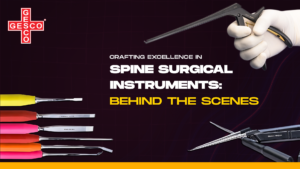Precision is of the utmost importance in today’s healthcare sector, especially when performing delicate procedures like spine surgery. Surgeons’ instruments and tools are the result of a meticulous fusion of advanced technology and skilled craftsmanship that goes into every successful spinal procedure. The process of creating superior spine surgical instruments involves deep exploration of creativity and commitment.
The Craft of Precision – A pursuit of accuracy lies at the heart of spine surgery. Patient outcomes may be significantly impacted by even the smallest variance. As a result, the instruments employed in these processes need to be as accurate and reliable as possible. Every step of the production process, from original design to final inspection, is driven by this need for precision.
Creative Design – Great craftsmanship starts with creative design. To create equipment that specifically adapts to the requirements of spine surgeons, engineers and designers work closely together. To make sure that every instrument operates as best it can in the operating room, this calls for extensive study, prototyping, and testing. In order to improve surgical accuracy and efficiency, design factors include ergonomics, functionality, and equipment compatibility.
Components and Production – When making spine surgical equipment, material selection is crucial. Premium titanium and stainless steel alloys are preferred because of their biocompatibility, durability, and resistance to corrosion. Forging, heat treatment, and precision machining are some of the demanding manufacturing procedures these materials go through to get the appropriate strength and performance attributes. Complex geometries can also be precisely created by using advanced techniques like 3D printing.
Research and Creation – Innovation and research are essential to the pursuit of excellence. In-depth investigation of cutting-edge materials, technologies, and methods is part of this phase. The design of spine surgical instruments is driven by innovation through collaborations with academic institutions and industrial partners, which promote the sharing of ideas and expertise.
Testing and Prototyping – In the creation of spine surgical equipment, prototyping is an essential step. It enables designers to convert abstract concepts into observable prototypes for assessment and experimentation. Prototypes are put through rigorous performance evaluations in situations that resemble surgery, which yields important information about ergonomics, usability, and functionality. To guarantee peak performance and customer satisfaction, the design is refined through repeated testing and refining.
Accurate Machining – The foundation of the instrument manufacturing process is precision machining. Using sophisticated machining processes and computer numerical control (CNC) equipment, complex shapes can be produced with micron-level precision. Expert machinists carefully create every part, focusing on precision and excellence. To guarantee consistency and accuracy in the finished product, tight tolerances are upheld throughout the machining process.
Surface Plating – For spine surgery tools to function better and last longer, surface polishing is essential. By removing impurities and defects from the surface, methods like electropolishing and sterilisation increase corrosion resistance and biocompatibility. In addition to making cleaning and sterilisation easier, proper surface finishing lowers the risk of infection in the surgical environment.
Adherence to Regulations – When making spine surgical tools, compliance with regulatory criteria is a must. Manufacturers have to deal with a confusing maze of rules and regulations, such as those set forth by the FDA in the US and the European Union’s CE marking laws. Adherence to these guidelines guarantees the security, effectiveness, and calibre of tools, fostering trust among physicians and patients in equal measure.
Continuous Development – Achieving excellence is a process rather than a goal. Manufacturers are dedicated to ongoing development, motivated by input from patients, surgeons, and other medical specialists. Post-market surveillance and clinical feedback methods facilitate the identification of areas that require improvement and optimisation by manufacturers. The spine surgical instruments are improved through a continuous process that guarantees they keep up with the changing demands of the medical community.
Assurance of Quality – The foundation of excellence for spine surgery devices is quality assurance. For any instrument to be in adherence with industry norms and legal regulations, it must go through a thorough testing and inspection process. This covers mechanical strength, surface finish, dimensional correctness, and sterilisation compatibility. Manufacturers use sophisticated metrology methods, like optical inspection systems and coordinate measuring machines (CMMs), to confirm the accuracy of each equipment before it leaves the factory.
Collaboration and providing feedback – Excellence in crafting is a continuous process that benefits from input and teamwork. Manufacturers collaborate closely with medical specialists such as surgeons to comprehend their changing needs and obstacles. This cycle of feedback encourages innovation and constant improvement, which results in the creation of cutting-edge tools and methods for spinal surgery.
The meticulous instruments employed by surgeons are the instruments of a symphony of accuracy and quality that support every successful spine surgery. Every stage of the process, from creative design to rigorous manufacturing and quality control, is committed to guaranteeing the best possible outcomes for patients. Driven by a common dedication to developing the art and science of spine surgery, the pursuit of excellence in spine surgical instruments continues as technology and medical knowledge advance.
visit our website now now to know more.

